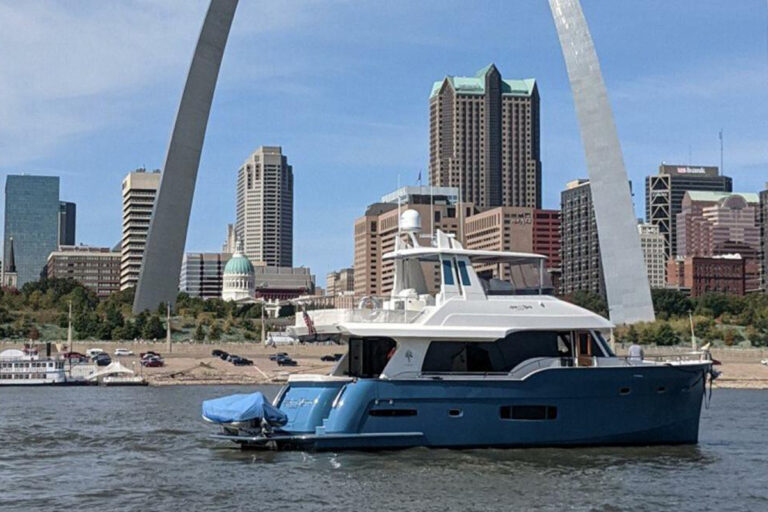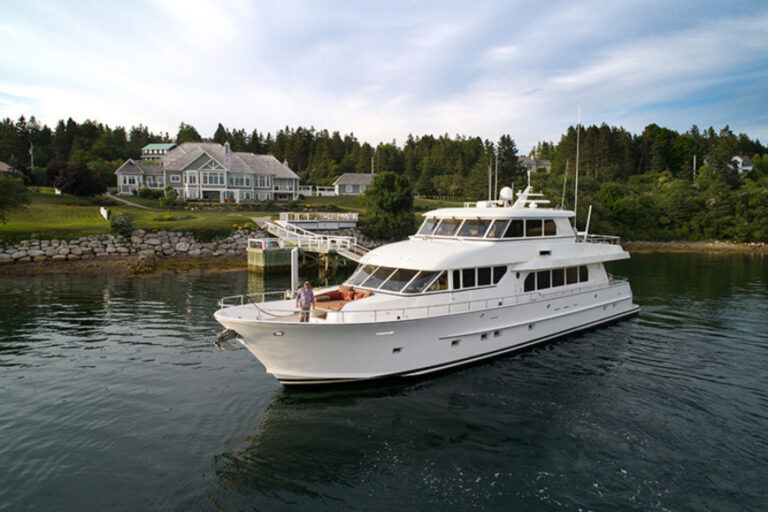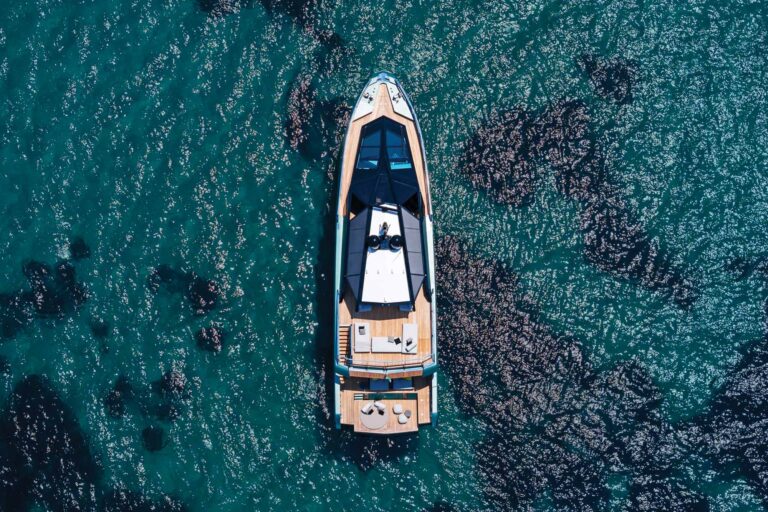Ten years ago, production boat owner Jim Martin met designer Tom Fexas on a railway platform in Italy. A year later, Martin and his wife, Nancy, decided to buy their first custom yacht. They called on Fexas to design the 53-footer, and on Knight & Carver in San Diego to build her.
“The 53 project spoiled us”, Jim Martin said. “When we began thinking about a bigger boat, Fexas and Knight & Carver were our first choice.”
Designing and building a boat from scratch can be a challenge, and this kind of repeat business is not easily earned. However, when the builder and designer remain on the same page as the guy writing the checks, the creative experience typically yields satisfying results. The Martins are enjoying similar success with their new 70-footer Makara-designed to offer a bit more speed and range than their 53-footer, and enough space for a captain and mate. Fexas prescribed a 70-foot design that incorporated existing tooling Knight & Carver had access to. A mold for a successful 78-foot Fexas hull was dammed to length, and new female tooling was built for the superstructure.
By the time I caught up with Makara in Palm Beach, the Martins had already logged more than 10,000 nautical miles. Following the boat’s launch in San Diego Bay, they headed south to Mexico and through the Panama Canal to Florida. They then headed north and spent the summer cruising the coast of Maine.
Our sea trial was offshore in deep water with cruising gear aboard and a half load of consumables (fuel and water). The 1,400 hp Caterpillar 3412Es spooled up quickly, and we reached planing speed in just under 20 seconds. I measured a top speed of 25.8 knots at 2260 rpm. This is a bit short of the Cats’ 2300 rpm potential, and Capt. Christopher Wills suggested that with a clean bottom, he would see the missing turns and a bit more speed.
Wills likes to cruise at 1950 rpm, around 22 knots. The yacht is comfortable at this speed, and the Caterpillar electronics indicated a fuel burn of 110 gallons per hour.
At the helm, Makara has a stout feel and responds predictably-banking comfortably inboard in high-speed turns and holding a steady course while loitering at idle speed. Active stabilizers are fitted, though Fexas says they are unnecessary on a vessel of this type. While I agree with Fexas that such hulls are inherently stable at speed, the comfort active stabilizers provide at low speed is worth any added resistance they might cause.
Makara‘s hull form has a fine entry designed to provide a soft ride in head seas, and a relatively shallow deadrise aft (about 13 degrees at the transom) to maximize lift. The transition in deadrise is facilitated by Fexas’ shapely keel design. Forward, she has a soft bilge with a molded-in ledge that extends aft. Her after sections have a hard turn at the bilge, and shallow propeller pockets are just deep enough to accommodate appropriate tip clearance (18 percent of wheel diameter). The propeller pockets also reduce shaft angle and shave a few inches off her draft.
Fexas and Knight & Carver were pioneers in foam-cored sandwich construction. Late 1970s Fexas designs featured cored hull bottoms, and Knight & Carver launched its first fully cored hull in 1976. Lightweight core materials allow designers and builders to increase the panel thickness and stiffness without piling on fiberglass and resin. This saves weight. While Makara is not ultra-light, her structure is about 20 percent lighter than it might have been if her bottom and topsides were solid fiberglass.
Her hull bottom is cored with double inch-thick Core-Cell linear polyurethane foam, sandwiched between skins composed of a blend of multidirectional stitched fiberglass reinforcement. Core materials were also used in the construction of her superstructure, decks and portions of her interior joinery.
The machinery space is accessible from the crew quarters or from the walk-in hanging locker in the owner’s suite (an often-overlooked asset that provides an emergency escape in both directions). Mechanical installations appear first class, and access to the main engines and the pair of 32kW Westerbeke generators is excellent. Intake air is channeled through demisters, and exhaust passes through the bottom and through idle bypasses at the transom. Fuel is carried in integral fiberglass tanks grouped around the center of buoyancy to minimize the effect on longitudinal trim.
More often than not, Fexas’ pen wanders outside of the box. Surprisingly, however, Makara‘s silhouette is quite conservative.
“I just can’t get into the modern Euro stuff everyone seems excited about, Jim Martin said. “We feel that Tom did a spectacular job at creating a tasteful American look.
I agree. Makara‘s clean, crisp lines flow easily, revealing a hint of West Coast flavor I find appealing. Fexas packaged a lot of accommodation space into 70 feet without creating a boxy, overstuffed silhouette.
Full-beam deckhouses are popular these days, and while the interior volume they provide is appealing, the Martins have spent enough time on the water to understand the limitations of such designs. Makara‘s side decks allow the crew to move fore and aft easily, without disturbing the owner’s party. There is seating on the afterdeck and at the bow, and deck gear can be stashed out of the way in lockers in the forward trunk.
The flying bridge is accessible from the afterdeck or the main cabin. There is helm and companion seating, as well as a lounge area and a wet bar. The boat deck accommodates a 15-foot tender.
Makara‘s saloon is finished in cherry and has a casual feel accented by a pair of very comfortable chairs and an antique chest. The galley is amidships, and a step leads up to the pilothouse and a lounge area. Doors to port and starboard allow quick access to the side decks and are useful when the captain is called upon to grab a line.
Stairs in the pilothouse lead belowdecks to a full-beam owner’s suite and two guest staterooms. Crew quarters for two are aft, accessible via the integral swim platform or a hatch in the afterdeck.
Jim Martin visited the yard a number of times during the 24 months of construction and hired project manager Art Bollinger to be on hand for the duration. Wills came aboard several months prior to launch. The efforts of all involved paid off.
“Building a custom boat requires patience”, Martin said, “but it’s worth the investment and the wait.”
Custom projects such as Makara are increasingly rare these days as production boats and foreign semi-custom offerings dominate the category. Those searching for something distinct might be surprised to find that the potential to create it exists right here at home.
Contact: Knight & Carver YachtCenter, (619) 336-4141; www.knightandcarver.com.









